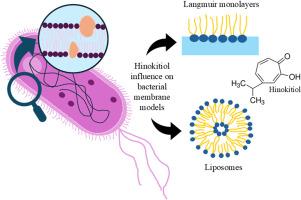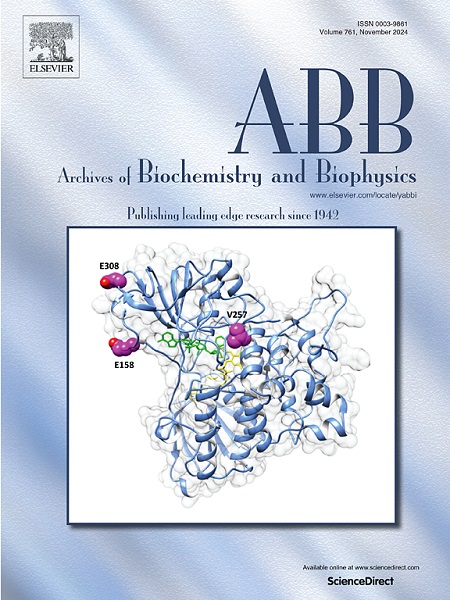Searching for the role of membrane lipids in the mechanism of antibacterial effect of hinokitiol
IF 3
3区 生物学
Q2 BIOCHEMISTRY & MOLECULAR BIOLOGY
引用次数: 0
Abstract
The aim of this work was to investigate the effect of monoterpenoid hinokitiol (β-thujaplicin) on the monolayers and bilayers composed of lipids typical for bacteria membranes and gain insight into the potential role of the lipids in antibacterial activity and selectivity of this compound. To explore this issue, the in vitro studies were performed on different bacterial strains to verify antibacterial potency of hinokitiol. Then, the experiments on E. coli and S. aureus bacteria membrane models (i.e. model multicomponent monolayers and bilayers) were done. Finally, the effect of hinokitiol on one component lipid monolayers was investigated. The lipids used in the experiments included Phosphatidylethanolamines (PEs), Phosphatidylglycerols (PGs) and Cardiolipins differing in the structure of the polar head and/or the hydrophobic chains. This choice allowed the analysis of correlations between the lipid structure and the effect of hinokitiol.
In vitro tests confirmed the antimicrobial activity of hinokitiol against most of the strains tested. In addition, the in vitro tests showed that E. coli bacteria were more sensitive to hinokitiol than S. aureus bacteria. Interestingly, the studies on model systems evidenced that hinokitiol molecules are of stronger effect on E.coli film and they are able to insert into these systems even at membrane-related surface pressures. Moreover, the structure of the lipid and its content in the model system correlated with the effect exerted by hinokitiol on the monolayer properties. It was found that hinokitiol differs in the affinity to particular lipids and additionally hinokitiol/lipid interactions may occur according to different mechanisms. Namely, depending on the lipid structure, hinokitiol may incorporate into the lipid film (Cardiolipins and PEs) or interact preferentially with the lipid polar head (PGs) and form hydrogen bonds. The effect of hinokitiol on the lipids was determined by the charge and size of the polar head as well as by the spatial size of the lipid molecule. Moreover, comparing the lipids of the same polar heads, hinokitiol caused stronger expansion of the film formed from the lipid having unsaturated chains. The results obtained may explain the difference in the effect of hinokitiol on particular bacterial strains. In conclusions, it can be suggested that the lipids should be considered as the bacteria membrane structural elements of a possible role in the mechanism of action of hinokitiol.

寻找膜脂在桧醇抗菌作用机制中的作用。
这项工作旨在研究单萜类化合物桧基二醇(β-thujaplicin)对由细菌膜典型脂质组成的单层和双层膜的影响,并深入了解脂质在该化合物的抗菌活性和选择性方面的潜在作用。为了探讨这个问题,我们对不同的细菌菌株进行了体外研究,以验证桧基硫醇的抗菌效力。然后,在大肠杆菌和金黄色葡萄球菌膜模型(即多组分单层和双层模型)上进行了实验。最后,研究了 hinokitiol 对单组分脂质单层的影响。实验中使用的脂质包括磷脂酰乙醇胺(PE)、磷脂酰甘油(PG)和在极性头和/或疏水链结构上不同的心磷脂。通过这种选择,可以分析脂质结构与桧醇效果之间的相关性。体外测试证实了桧醇对大多数受试菌株的抗菌活性。此外,体外测试表明,大肠杆菌比金黄色葡萄球菌对桧醇更敏感。有趣的是,对模型系统的研究表明,桧醇分子对大肠杆菌膜的作用更强,即使在与膜有关的表面压力下,它们也能插入这些系统。此外,模型系统中的脂质结构及其含量与桧醇对单层特性的影响相关。研究发现,桧基硫醇对特定脂质的亲和力不同,此外,桧基硫醇与脂质之间的相互作用可能会根据不同的机制发生。也就是说,根据脂质结构的不同,桧醇可能会融入脂质膜(心磷脂和聚乙烯)中,也可能优先与脂质的极性头(PGs)相互作用并形成氢键。桧醇对脂质的影响取决于极性头的电荷和大小以及脂质分子的空间大小。此外,与具有相同极性头的脂质相比,桧醇会使具有不饱和链的脂质形成的薄膜产生更强的膨胀。这些结果可以解释桧基硫醇对特定细菌菌株的不同影响。总之,可以认为脂质应被视为细菌膜结构元素,在桧醇的作用机制中可能发挥作用。
本文章由计算机程序翻译,如有差异,请以英文原文为准。
求助全文
约1分钟内获得全文
求助全文
来源期刊

Archives of biochemistry and biophysics
生物-生化与分子生物学
CiteScore
7.40
自引率
0.00%
发文量
245
审稿时长
26 days
期刊介绍:
Archives of Biochemistry and Biophysics publishes quality original articles and reviews in the developing areas of biochemistry and biophysics.
Research Areas Include:
• Enzyme and protein structure, function, regulation. Folding, turnover, and post-translational processing
• Biological oxidations, free radical reactions, redox signaling, oxygenases, P450 reactions
• Signal transduction, receptors, membrane transport, intracellular signals. Cellular and integrated metabolism.
 求助内容:
求助内容: 应助结果提醒方式:
应助结果提醒方式:


